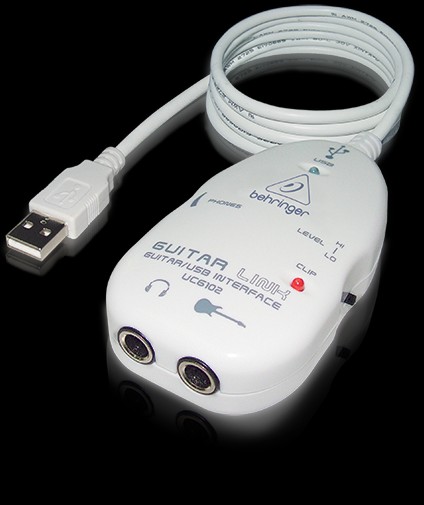Behringer Guitar Link UCG102
I have been playing with this thing for about two weeks now, and I have had a LOT of fun! It’s easy to use, gives me a good solution for recording my guitar without getting the police called on me, and I even like the color! Though I do have some complaints. Read on, dear reader, read on.
The What
So what exactly is the Guitar Link UCG102 ?
Simply put, this device is an interface that connects your guitar to your computer for recording and/or amplification purposes.
From Behringer’s website:
“The UCG102 is a USB interface that, like a guitar amp, receives signal from your guitar via a 1/4″ input jack. A built-in USB cable then sends signal directly to your computer, where the amazing included software package simulates guitar amps and stomp boxes, in addition to tracking your latest masterpiece. It has a 1/4″ headphone jack and PHONES volume dial so you can monitor your performance as you record, a CLIP LED to tell you when your signal is too hot, and a HI/LO level selector.”
The Good
When my review model arrived, I was anxious to get started with it, so I tore it out of the box and plugged it in. My PC detected it immediately with no issues. The Driver version that came with it was for 32 to bit operating systems, but a quick Google search led me to Behringer’s website where a 64 bit driver was available for quick, free download.
With the right driver installed, the device immediately registered sound on my PC’s mixer and in my chosen DAW, Reaper. After selecting the driver in Reaper’s preferences, I was able to get some direct-in guitar takes recorded with no additional fuss.
Of course, unprocessed direct-in electric guitar takes don’t sound so great, so it was time to take a look at the Amp Modeling software that comes with the device. There are three Guitar Combo amp models from Native Instruments available for demo, and one of the three, the AC box combo comes with a free license.
I was able to dial up some very pleasing sounds on all three amps, though the Plexi Combo was by far the most versatile of the three, allowing for the most tone tweaking and capable of producing the most modern sounding tones, particularly with distortion. The device delivers quite well on it’s promise of ultra-low latency interfacing. I was showing 5ms of latency most of the time and occasionally getting as high up as 15ms when playing, monitoring on headphones, and recording all at once. I found that the latency was never noticeable on playback of recordings, but when it got a bit higher it could be detected to some degree when monitoring. Of course, I run a decently powerful gaming computer rig, so your mileage may vary on this. Outside of the aforementioned occasional latency, the headphone jack worked with no complaints, and the sound I got through it was high quality and was true to what was produced in recordings and playback.
The Bad
My big complaint is with the software packaged with the device. The Behringer driver hogged my computer’s audio stream, so that while using it, I had to switch it on to record, then switch back to my ASIO4ALL driver to hear playback. As you can imagine this was pretty frustrating, and in the end I switched to using ASIO4ALL for both. This worked great.
As stated earlier, I was able to get some pleasing sounds out of the Guitar Combo software that came packaged with the device, but having said that, overall I wasn’t pleased with it. In VST mode, the amp models seemed to randomly switch from sounding fine to making horrific crackling and popping noises. This would also occur every time I duplicated a track with one of these models on it. Also, this issue occurred most of the time if I saved and closed a working file then reopened it. I was able to get around this issue most of the time by opening and closing the FX chain where the Guitar Combo VST was present, but it was definitely disruptive to my attempts at recording. At first I thought this issue might only be a problem with Guitar Combos working on Reaper, but after trying the standalone versions of the guitar combo software several times I was able to get the same issue to occur here and there.
I mentioned before that the AC box combo came with a free license. Two complaints:
1. It’s very limited – With only a two band EQ and not much going on in terms of modeling options, this is probably not going to become a staple guitar plug in for most users. It does produce some good sounding classical rock distorted tones, and some decent clean sounds, but in the end I really just don’t feel you can do that much with it.
2. The automatic registration process to upgrade from demo to registered version did not work for me. I tried it more than a dozen times, on several different days, and after rebooting my computer multiple times, and always got the same result: The Native Instruments window would come up, with a dialog box that said “Checking Internet Connection”, and after a short while the check would fail. My internet access was working just fine every time I tried this. I was offered an offline alternative for activation, and was frustrated by the lack of functionality with this option as well. A checkbox list of both all three guitar combos appeared, and no matter how many times I tried unchecking the PLEXI and TWANG combo options, the next screen wanted keys for ALL THREE. I don’t have keys for all three, so I didn’t know what to do here, so I gave up.
Grr.
One problem that I found with the actual device itself: There is a switch on the interface with “HI” and “LO” settings. Every time I tried playing or recording on the “LO” setting, my guitar sounded buzzy, crackly and distorted. I’m not sure if there is just something I am missing here or not, but I ended up leaving the device on “HI” the whole time.
The Bonus
When all was said and done with my guitar, I decided to get my synthesizer out and see if the interface could deal with it. To my pleasant surprise, it handled it perfectly. The sound I got on recordings was perfectly true to what I got running the same synth patch through an amplifier.
I couldn’t get the headphones jack to work with my synth, but Behringer can’t be faulted for that since this device was designed for guitar. I also got out my bass guitar to see how well that worked. The only issue I encountered with this is that the output came out pretty quiet. Since the interface had handled the lower register sounds from my synth with no issues, I have to assume this is just because the signal output on my bass is lower than the interface is designed for. Bass guitar sounds are decently fixable for recording purposes with post processing though.
Overall
At the price this device is offered for, ($33 on Amazon) I have to say it is a great value and I strongly recommend it. It won’t replace top-of-the line solutions in recording studios anytime soon, and most users probably won’t like the software it comes with very much. But if you are a do-it-yourselfer with a good computer rig who, like me, can’t blast a loud guitar amp in your neighborhood, this little gadget will be tough to beat for laying down some excellent sounding guitar tracks. And as implied in “The Bonus” section, the resourceful among you will also be able to make other uses of it to.
Lastly, I have recorded a little demo with the device to show you what it can do. This was composed, recorded, and mixed haphazardly mostly in one day, but I still think it is a nice little sample of how much sound the Guitar Link will let you get out of your computer. The Guitar, Bass, and Synth were all recorded through the Guitar Link interface, while the drums are sampled.
[audio:https://media-geeks.com/////wp-content/uploads/2012/05/30/reviewdemo.mp3|titles=Demo]Happy Axe-ing!




















Hello. I had the same problem with activation. So I go to Native Instruments site, make an account and download the latest Service Center software. After I installed that, I activate the AC Combo in seconds :) I hope this information will solve your problem, too.
Bogdan
Hey –
I was using this interface as a cheap tool to record some tracks on my mac. I came across the same problem with the output being too quiet. Do you have any cheap alternative interfaces that work with bass?